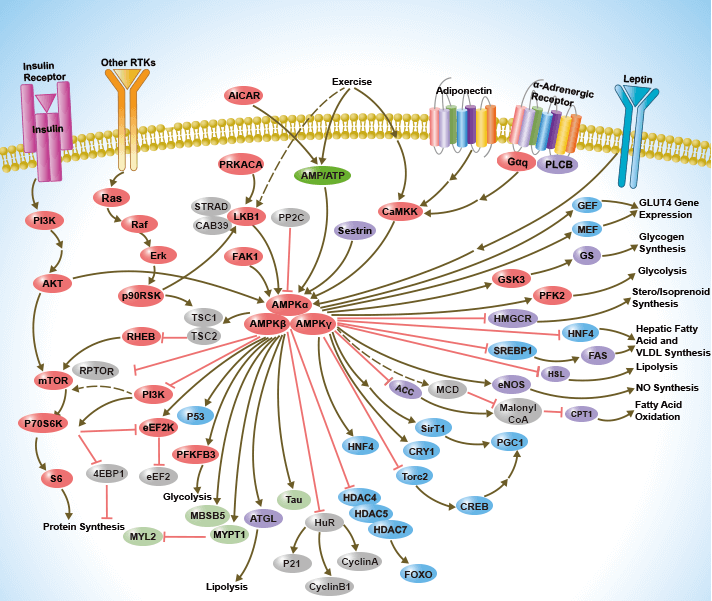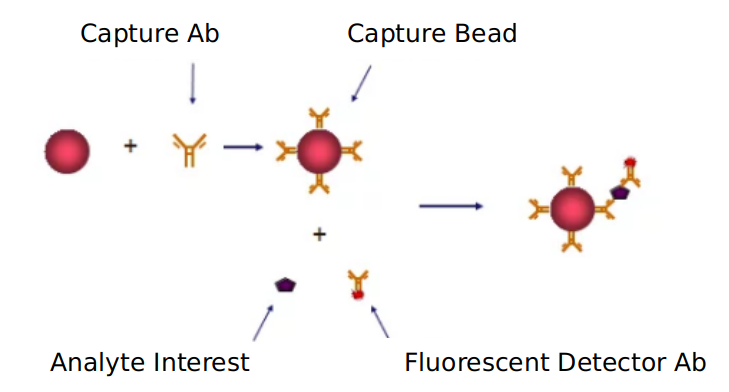Introduction to AMPK signaling pathway
Based on Luminex technology platform, Creative Proteomics provides analysis services for key targets of AMPK signaling pathway.
AMP-activated protein kinase (AMPK) signaling pathway, a fuel sensor and regulator, promotes ATP-producing and inhibits ATP-consuming pathways in various tissues. AMPK is exists as a heterotrimeric complex composed of a catalytic α subunit and regulatory β and γ subunits.
Binding of AMP to the γ subunit allosterically activates the complex, making it a more attractive substrate for its major upstream AMPK kinase, LKB1. In response to low ATP levels, AMPK activation promotes signaling pathways that generate more ATP, including fatty acid oxidation and autophagy, and inhibits anabolic ATP-consuming processes including gluconeogenesis, lipid and protein synthesis. When nutrients are scarce, AMPK also acts as a metabolic checkpoint inhibiting cellular growth. For example, activation of AMPK enhances both the transcription and translocation of GLUT4, resulting in an increase in insulin-stimulated glucose uptake. In addition, it also stimulates catabolic processes such as fatty acid oxidation and glycolysis via inhibition of ACC and activation of PFK2.

AMPK negatively regulates several proteins central to ATP consuming processes such as TORC2, glycogen synthase, SREBP-1 and TSC2, resulting in the downregulation or inhibition of gluconeogenesis, glycogen, lipid and protein synthesis. Due to its role as a central regulator of both lipid and glucose metabolism, AMPK is considered to be a key therapeutic target for the treatment of obesity, type II diabetes mellitus, and cancer.
AMPK is a central regulator of cellular energy homeostasis, playing critical roles in regulating growth and reprogramming metabolism as well as in cellular processes including autophagy and cell polarity. The kinase is activated in response to stresses that deplete ATP supplies such as low glucose, hypoxia, ischemia, and heat shock. AMPK activation works through direct phosphorylation of multiple enzymes directly involved in these processes as well as through transcriptional control of metabolism by phosphorylating transcription factors, co-activators, and co-repressors.
Our detectable targets:
| AICAR | PI3K | Ras | AKT | mTOR | p70S6K |
| S6 | Raf | Erk | p90RSK | RHEB | eEF2K |
| p53 | PFKFB3 | MYL2 | MBSB5 | MYPT1 | ATGL |
| Tau | p21 | HuR | CyclinA | CyclinB | FAK1 |
| LKB1 | PRKACA | AMPKα | AMPKβ | AMPKy | HDAC4 |
| HDAC5 | HDAC7 | FOXO | HNF4 | Torc2 | CREB |
| PGC1 | CRY1 | SirT1 | ACC | MCD | CPT1 |
| eNOS | HSL | FAS | SREBP1 | HMGCR | PFK2 |
| GSK3 | GS | MEF | GEF | PLCB | Gaq |
| CaMKK | Sestrin | PP2C | AMP | ATP |
Technology platform
We provide Luminex technology for AMPK signaling pathway analysis.
Luminex technology is a multifunctional liquid phase analysis platform developed on the basis of colored microspheres, laser technology, applied fluidics and high-speed digital signal processing technology. The core is to encode polypropylene microspheres or magnetic microspheres with fluorescent dyes. By adjusting the different ratios of the two fluorescent dyes, up to 100 microspheres with different fluorescence spectra can be obtained. Each kind of microspheres is covalently cross-linked. Capture antibodies against specific antigens.
AMP-activated protein kinase (AMPK) is a central regulator of cell energy homeostasis and plays a key role in regulating growth and reprogramming metabolism and cellular processes including autophagy and cell polarity.
In addition to Luminex Multiplex Assay, Enzyme-linked immunosorbent assay (ELISA), Flow cytometry (FACS analysis) technology can also be provided to meet other customer needs.
Advantages of AMPK signaling pathway detection:
- High-throughput and high-speed: Each microsphere is used as a separate test body, which can perform a large number of biological tests at the same time. It only needs 10~201 samples to test up to 100 indicators at a time, and the fastest can reach 10,000 tests /hour.
- High flexibility: specific probes, antigens or antibodies can be connected to the microspheres to meet the needs of different customers.
- Good repeatability: similar homogeneous reaction mode, each indicator has 1000-5000 reaction units, and the median value of 100 analysis is taken. High accuracy: the detection range is 35-6 orders of magnitude, which is very strong with ELISA and mass spectrometry.

Application of our service:
- To study the effect of each virus on AMPK signaling pathway
- To study the effects of drugs or therapies on AMPK signaling pathways
- To study the regulation mechanism of AMPK signal pathway in disease
Creative Proteomics has developed a signal pathway target detection platform. We are not limited to providing AMPK signaling path detection services, but can also provide other signal path detection services. If you want to detect other targets, please contact us and we will customize the service for you. Look forward to working with you.
References:
- Cantó C, Auwerx. JAMP-activated protein kinase and its downstream transcriptional pathways. Cell. Mol. Life Sci, 2019, 67(20): 3407–23.
- Carling D, Mayer FV, et al. AMP-activated protein kinase: nature's energy sensor. Nat. Chem. Biol, 2018, 7(8): 512–518.
- Hardie DG. AMP-activated protein kinase: an energy sensor that regulates all aspects of cell function. Genes Dev, 2020, 25(18): 1895–908.
- Hardie DG, Ross FA, et al. AMP-Activated Protein Kinase: A Target for Drugs both Ancient and Modern. Chem. Biol, 2019, 19(10): 1222–1236.



